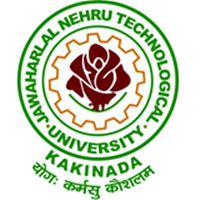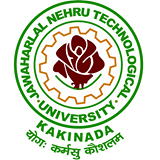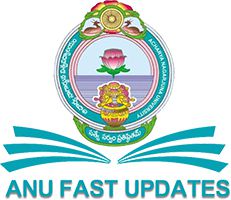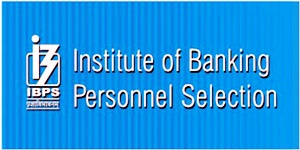AP EAMCET BiPC Counselling Dates 2020 Rank Wise, Certificates Verification, web options, seat allotment details are available at apeamcetb.nic.in. The Qualified and eligible candidates of APEAMCET-2020 ( Bi.P.C stream) desirous of seeking admission into B.Pharmacy, Pharma-D, B.E./B.Tech(Bio-Technology and Pharmaceutical Engg) Courses are informed that the web counseling process comprising payment of processing fee, certificate verification & Option entry will be conducted from 08-02-2021 onwards. The candidates are instructed to follow guidelines/Instructions to proceed for web counseling process.
AP EAMCET BiPC Counselling Dates 2020 Rank Wise, Certificates Verification @ apeamcetb.nic.in
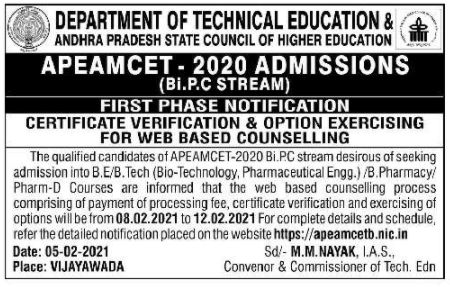
Qualified and eligible candidates of APEAMCET-2020(Bi.P.C. Stream) are informed to participate in web counseling for the seats available in Pharmacy colleges in the State of Andhra Pradesh(both University and Private) for the academic year 2020-21 on payment of processing fee as given below.
Payment of Processing fee:
Rs.1200/- (for OC/BC) and Rs. 600/- (for SC/ST) through online by credit card/ debit card/ (or) net banking through the “ Pay Processing Fee” link in the web site https://apeamcetb.nic.in.
All the candidates from 1 to Last Rank can pay the processing fee from 08.02.2021 onwards using URL https://apeamcetb.nic.in .
- Processing fee can be paid through online using credit card or debit card or through internet banking.
- Enter URL https://apeamcetb.nic.in and click on “Pay Processing Fee “
- Enter APEAMCET Hall Ticket number and rank and click on “Pay Fee Online. “
- The candidate will be directed to payment gateway.
- Select any one mode of payment i.e credit card or debit card or net banking and enter credentials.
- Once the payment is success click on print button and take a print out.
Important Note: During the payment of processing fee sometimes due to network delays payment made by the candidate may not be successful. In such cases candidates need to pay the processing fee once again and amount debited due to the failure transaction will be remitted back into the respective account within 4 working days from the date of payment. If the excess payments are not remitted in 4 working days candidate has to send information like Hall ticket number, Transaction Id, Date of Payment etc to the Email Id: cetsrefund2020@gmail.com and action will be taken immediately for refund. Candidates are requested to note that only one payment will be taken and excess paid will be refunded automatically.
Verification of Certificates:
- On payment of processing fee, Registration number and Login ID number will be provided through SMS for the Mobile number furnished at the time of filing the application or modified mobile number to all such candidates whose certificate data is already verified through web services. For candidates whose certificate data is incomplete an SMS is sent to attend for verification of certificates at HLC.
- On confirmation of the displayed data, candidate can create password.
- Login ID, Hall Ticket number, date of birth and password already created can be used to enter the options from Internet facility available at Home/Internet Café/Helpline Center.
- In respect of candidates whose data is incomplete/ not verified the registration tab will not be opened and a message saying your certificates not verified please contact nearest Help Line Centers for certificate verification such candidates have to visit nearest help line centre and get the certificates verified and proceed for option entry.
- Candidates are informed that the verification of certificates viz S.S.C. memo, Intermediate marks memo, VI class to Intermediate study certificates, Caste Certificate, Income Certificate/Ration Card, Economically Weaker section(EWS) certificate, Physically Challenged Certificate, Residence Certificate have to be verified by the counseling authorities.
- However, candidates are requested to note that these certificates were already verified through web services from the respective board/agencies based on the information furnished by the candidate while applying for APEAMCET2020 i.e., Common Entrance Test.
- However, in some cases the verification may be incomplete. Hence the candidates are requested to note the following.
- After payment of processing fee Click on “Verification Status”
1. Enter Hall ticket Number and click on “Show” button.
2. The candidate details will be displayed and at the bottom of the screen the candidates whose certificates got verified online will get display message “ Candidate is eligible for exercising options“ all such candidates need not go to Help line centers for certificate verification and they have to proceed to option entry as per the schedule given in the notification.
3. The candidates whose certificates are not verified online will get display “candidate is not eligible” then such candidates have to go to Help line centers and get their certificates verified and they have to proceed to option entry as per the schedule given in the notification
4. If the candidate is not agreeing with the data verified, candidate is directed to visit the nearest Helpline Centre with all original certificates for verification.
5. Verified candidates need to check the Eligibility for Fee Reimbursement, if it is displayed as “NO” but you are eligible for Fee Reimbursement then after paying the Processing Fee go to the nearest Helpline Centre with Original Income Certificate/Ration card to get Fee Reimbursement Eligibility.
6. Verify the mobile number displayed in the verification status for correctness as all the counseling information will be sent to this mobile number only. If candidate wants to change his/her mobile number visit nearest Helpline Centre and request to change the mobile number in writing to HLC coordinator.
7. The Candidate is requested to verify all the details displayed and the Candidate wishes to change the data like Date of Birth, Gender, Region, Caste, Fee Exemption, Minority, Mobile Number etc approach nearby Help Line Center with Original certificates for verification.
The following is the schedule for verification of certificates:
SCHEDULE FOR CERTIFICATE VERIFICATION FOR OC/BC/SC/ST CANDIDATES(WHOSE DATA IS INCOMPLETE)
(REPORTING TIME 9.00 A.M. Everyday) AT HELP LINE CENTERS
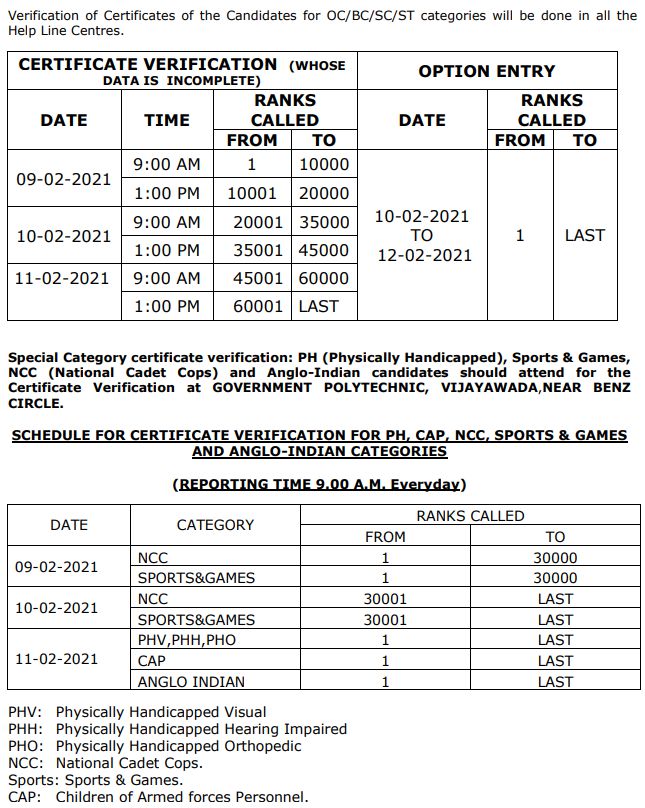
It is informed that the other certificates of these candidates will also be verified on the dates mentioned above along with Special Reservation category Certificates. Allotments will be placed on the website on 14.02.2021 after 6.00 PM. For vacancies and other details please visit: https://apeamcetb.nic.in.
List of Help Line Centers:
1. Government Polytechnic, Srikakulam
2. MRAGR Government Polytechnic, Vizianagram
3. Government Polytechnic, Kancharapalem, Visakhapatnam
4. Andhra Polytechnic, Kakinada
5. S.M.V.M Polytechnic, Tanuku, West Godavari dist
6. Government Polytechnic, Vijayawada
7. Andhra Loyola Degree College, Near Benz Circle, Vijayawada.
8. MBTS Government Polytechnic, Nallapadu, Guntur.
9. D.A Government Polytechnic, Ongole
10. Government Polytechnic, Venkateswarapuram, Nellore
11. S.V Government Polytechnic, Tirupathi
12. Government Polytechnic for women, Kadapa
13. Government Polytechnic, Ananthapur
14. Sri G.Pulla Reddy Government Polytechnic, Kurnool
Certificates to be produced by candidates
All original Certificates and two sets of Xerox copies
1) APEAMCET-2020 Rank card.
2) APEAMCET-2020 Hall Ticket.
3) Memorandum of Marks (Inter or its equivalent).
4) Proof of Date of Birth (SSC or its Equivalent Memo).
5) Transfer Certificate ( T.C)
6) Study Certificate from VI to Intermediate
7) EWS certificate valid for the year 2020-21 from MeeSeva for OC candidates who want to claim reservation under EWS category
8) Residence Certificate of candidate for a period of 7 years preceding to qualifying examination(Inter or its equivalent examination) in case where the candidate has no institutionalized education.
9) Andhra Pradesh Residence Certificate of father/mother for a period of 10 years excluding the period of employment outside Andhra Pradesh from Tahsildar in respect of Non-Local Candidates.
10) Integrated Community Certificate, in case of BC/ST/SC issued by the competent authority.
11) Income certificate of parents from all sources issued on or after 01.01.2017 or White Ration card (candidate name and either of the parents name have to be reflected in the ration card) those who claim tuition fee reimbursement
12) Local status certificate (if applicable) i.e a candidate who migrates to any part of the state of Andhra Pradesh from the state of Telangana from 02-June-2014 to on/before 01-June2021shall be regarded as the local candidate in the state of Andhra Pradesh.
13) Candidates claiming reservation under NCC/Sports/ PH/ CAP shall bring the original certificates.
a) PH – Candidates shall submit certificate issued by the District Medical Board.
b) CAP – Candidates shall submit Certificates from the Zilla Sainik Welfare Board (viz) Discharge book & Identity card etc for Verification. Children of Ex-Service and In-Service persons who are domicile of Andhra Pradesh will alone be considered for allotment of seats under CAP Category.
c) NCC & Sports –Produce original certificates issued by competent authorities. The candidate should have represented from the state of AP.
d) Minorities – The Muslim and Christian Minority Candidates should bring TC of the SSC containing the Religion (Muslim/Christian/Other linguistic) or in the absence of TC, a Certificate issued by the Head of the Institution in which the student studied/appeared for SSC or its equivalent Examination. e) Anglo-Indian: A Certificate issued by Tahsildar of their place of Residence.
NOTE: As per the Government orders the (i) “Jagananna Vidya Deevena (RTF)” and (ii) “Jagananna Vasathi Deevena (MTF)” schemes shall be applicable to the students admitted in Pharm-D course under convener quota, either under regular or selffinance mode, in the Private Aided and Private Unaided Degree/PG Colleges from the academic year 2020-21 fresh admissions for the FIRST FOUR YEARS ONLY OUT OF 6 YEARS INTEGRATED COURSE.
AP EAMCET (BiPC) – 2020 :: Detailed Notification
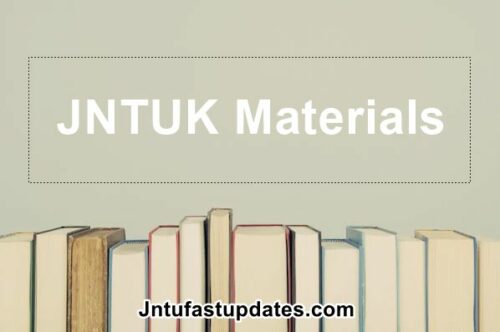

320-x100(1).gif)

